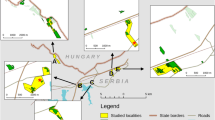Abstract
We surveyed populations of Eurodryas aurinia (a butterfly listed as ‘Threatened in Europe’) in Glamorgan (South Wales, UK). The survey may provide a model for similar work, which is urgently needed throughout the species' European range. For each colony, we established population size, vegetation types, and current management regimes. Populations were assessed using larval surveys, a method which has several advantages over conventional adult surveys. With approximately 35 local populations, Glamorgan is among the most important areas for E. aurinia in the UK, and is of importance in a European context. However, 15 local populations were under immediate threat from unfavourable management or industrial developments, and only seven populations were on Sites of Special Scientific Interest. Colonies showed a clustered pattern, and varied greatly in size: 50% supported 20 or fewer larval webs. Many of the small populations may be temporary offshoots of larger, more permanent populations nearby. The largest local populations occupied Molinia caerulea - Cirsium dissectum fen meadow habitats (National Vegetation Community M24), which were unmanaged, grazed by cattle, horses or ponies, or subject to periodic burning. Detailed local surveys such as this one, which assess the relative sizes of populations and the impact of current management practices, may be the best way to plan future conservation measures for E. aurinia.
Similar content being viewed by others
References
Boorman, S.A. and Levitt, P.R. (1973) Group selection on the boundary of a stable population. Theoret. Popul. Biol. 4, 85–128.
Ford, H.D. and Ford, E.B. (1930) Fluctuation in numbers, and its influence on variation, in Melitaea auriniaRott. (Lepidoptera). Trans. Ent. Soc. Lond. 78, 345–51.
Fowles, A.P. (1994) Invertebrates of Wales: a Review of Important Sites and Species. Peterborough: JNCC.
Gilpin, M.E. and Hanski, I. (eds) (1991) Metapopulation Dynamics: Empirical and Theoretical Investigations. London: Academic Press.
Harrison, S., Murphy, D.D. and Ehrlich, P.R. (1988) Distribution of the bay checkerspot butterfly Euphydryas editha bayensis: evidence for a metapopulation model. Amer. Natur. 132, 360–82.
Heath, J. (1981) Threatened Rhopalocera(butterflies) in Europe. Nature and Environment series no. 23. Strasbourg: Council of Europe.
Heath, J., Pollard, E. and Thomas, J.A. (1984) Atlas of Butterflies in Britain and Ireland. Harmondsworth: Viking.
Hurford, C. (1993) The Status ofE. aurinia (the Marsh Fritillary Butterfly) on Selected Sites in Glamorgan and Gwent, 1992. CCW Species and Monitoring Branch, Report 92/2/5. Roath, Cardiff: Countryside Council for Wales.
Kirby, P. (1992) Habitat Management for Insects: a Practical Handbook. Sandy: RSPB.
Levins, R.A. (1970) Extinction. Lect. Notes Math. Life Sci. 2, 77–107.
Lewis, O.T. (1993) Survey and Monitoring of the Breeding Status of the Marsh Fritillary in Glamorgan. CCW Contract Science No. 73. Roath, Cardiff: Countryside Council for Wales.
Oates, M.R. and Warren, M.S. (1990) A Review of Butterfly Introductions in Britain and Ireland. Godalming, Surrey: World Wide Fund for Nature.
Porter, K. (1981) The population dynamics of small populations of the butterflyEuphydryas aurinia. DPhil thesis, University of Oxford.
Pulliam, R. (1988) Sources, sinks and population regulation. Amer. Natur. 132, 625–61.
Rodwell, J.S. (1992) British Plant Communities: Volume 3; grasslands and montane communities. Cambridge: Cambridge University Press.
Thomas, C.D. (1994) Local extinctions, colonizations and distributions: habitat tracking by British butterflies. In Individuals, Populations and Patterns in Ecology(S.R. Leather, A.D. Watt, N.J. Mills, and K.F.A. Walters, eds) pp. 319–37. Andover, UK: Intercept.
Thomas, C.D. and Hanski, I. (1997) Butterfly metapopulations. In Metapopulation dynamics: ecology, genetics and evolution(I. Hanski and M.E. Gilpin eds) pp. 359–86. London: Academic Press.
Thomas, C.D. and Harrison, S. (1992) Spatial dynamics of a patchily distributed butterfly species. J. Anim. Ecol. 68, 437–46.
Thomas, J.A. and Simcox, D.J. (1982) A quick method for estimating larval populations of Melitaea cinxiaL. during surveys. Biol. Conserv. 22, 315–22.
Van Swaay, C.A.M. (1990) An assessment of changes in butterfly abundance in the Netherlands during the twentieth century. Biol. Conserv. 52, 287–302.
Warren, M.S. (1991) Euphydryas auriniadata sheet. Convention on the conservation of European wildlife and natural habitats. Strasbourg: Council of Europe.
Warren, M.S. (1994) The UK status and suspected metapopulation structure of a threatened European species, Eurodryas aurinia(the marsh fritillary). Biol. Conserv. 67, 239–49.
Author information
Authors and Affiliations
Rights and permissions
About this article
Cite this article
Lewis , O.T., Hurford , C. Assessing the status of the marsh fritillary butterfly (Eurodryas aurinia): an example from Glamorgan, UK. Journal of Insect Conservation 1, 159–166 (1997). https://doi.org/10.1023/A:1018403730808
Issue Date:
DOI: https://doi.org/10.1023/A:1018403730808




